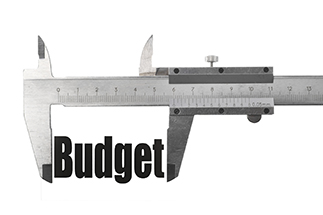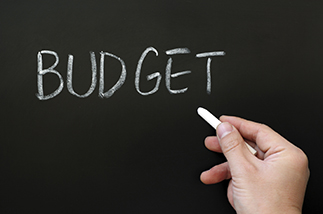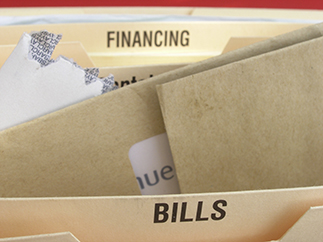Top tips for debt management
 When you’re in debt, there often seems no way out. How do you make your money stretch further to not only make the repayments, but get your debts under control? While we read a lot about bankruptcy, there are other debt solutions – but they take time, diligence and dedication.
When you’re in debt, there often seems no way out. How do you make your money stretch further to not only make the repayments, but get your debts under control? While we read a lot about bankruptcy, there are other debt solutions – but they take time, diligence and dedication.
There are no quick-fix solutions for debt management, despite the ads you might see on television that suggest one phone call can solve all your problems. Yes, you might get a lump sum to solve your short-term crisis from that one phone call – but these companies generally charge high interest rates so, in the long-term, you’re buying yourself a bigger problem.
True debt-management might take a little longer to achieve, but, if you do it right, you’ll be on top of your debt now and in the future.
1. Get serious – If you’re serious about getting on top of your debt, the first thing to do is to stop adding to it. Cut up your credit cards, store cards and anything else that allows you to spend money you don’t have. Ignore seductive “interest-free for 6 months” deals – buy it in 6 months when you can afford it.
2. Do a debt assessment – Do you have a clear idea of what you owe? This is where you get out all your statements – credit cards, store cards, car loan, home loan, and anything where you owe money and add it all up.
3. Know your interest rates – Credit card interest rates vary. Do you know how much you’re paying? What about on your home loan? Car loan? As well as knowing what you owe, you need to understand how much it is costing you.
4. Tackle the high-interest debt first – If you have two credit cards and one is costing you 20% per year and the other is costing you 11% per year, aim to pay off the card with the higher interest rate first. Car loans are another high-interest debt that you should aim to pay off as quickly as possible.
5. Always pay more than the minimum repayment –Every little bit extra that you can throw at the debt will reduce the time (and the interest paid!). You could even end up paying the amount back twice – i.e. if you borrow Ksh30 000 you will end up paying back Ksh60 000. So try and pay off a debt as soon as possible.
 6. Find the extra money by doing a budget – It always comes back to this with money, doesn’t it? Just as you need a clear idea of what you owe, you also need a clear idea of what you’re spending. You’re looking for money to redirect towards your debt. Learn more about family budgeting here
6. Find the extra money by doing a budget – It always comes back to this with money, doesn’t it? Just as you need a clear idea of what you owe, you also need a clear idea of what you’re spending. You’re looking for money to redirect towards your debt. Learn more about family budgeting here
7. If you have debt, you have no savings – Many people make the mistake of carrying credit card debt and trying to build up their savings at the same time. There’s not a lot of point in having savings (earning 5 – 7% maximum) and carrying a lot of credit card debt (at 11 – 20%). Use your savings to pay off as much debt as you can and continue to redirect that money until the debt is gone. Once your balance is at zero, you can direct the “savings” money as well as any money you used to spend on monthly debt repayments into your savings account.
8. Transfer your credit card balance – Credit cards are a big business today with banks and providers making a fortune off finance charges. The APR on most credit cards hovers around 16%. With that kind of interest levied on the card holder, it’s tough to pay off the dues within the specified date. Balance transfer thus evolved which is a transfer of a current amount owed in one credit card to another one, subject to a rate of interest. Many companies offer a free balance transfer in order to lure customers to using their services. Balance transfer on credit cards in Kenya is quite popular due to the low rates of interest on the transferred balance. For most customers in Kenys, balance transfers are ideal ways to reduce their credit card debts.
9. Consider consolidation – Taking out a personal loan to cover your debts can work well. Personal loans often attract a lower interest rate than credit card, store card and car loans, and have the added benefit of set repayments that are designed to pay off the card within a certain period of time (unlike minimum repayments on a credit card). If you follow this course of action, it’s vital that you cut up your credit cards – otherwise you may end up with a Ksh10 000 personal loan and new credit card debt.
10. Consider extending your mortgage – The other alternative to consolidation for those with a home loan is to extend your mortgage to cover your debts. Mortgages attract much lower interest rates and, once again, have set repayments. The key, if you choose this course of action, is to try to throw as much money into the mortgage as possible until the “extension” is paid down. Otherwise, you may end up paying off your loan over a period of 20 to 30 years – and that can be very expensive in interest charges.
Things to keep in mind with balance transfer
Although, the concept of a balance transfer is quite simple, there are some steps involved in moving the amount from one card to another. Still, regardless of the transfer rate, it is essential for you to do some groundwork before committing to a balance transfer. There are three things you should always bear in mind:
First - consider your credit situation.
If you have a solid credit history with a record of consistent on-time payments, you are likely to qualify for a low interest credit card to where you can transfer your outstanding balances on your previous card. This will save you a lot of money in interest charges.
Second - consider the amount of money you are planning to transfer.
For example, if you have Ksh50 000 in outstanding balances on one or more credit cards, it is unlikely you can move the entire amount into a low interest credit card. If you can transfer a small portion of the outstanding amount, it still is a productive step towards lowering your overall interest costs. So, it is important to weigh your options and the amount you are likely to transfer.
Third - consider the fees that are charged to you when transferring balances from one card to another.
Unless it’s stated that no up-front charges exist, balance transfer fees are always there. Read the fine print before you encounter any shock.


